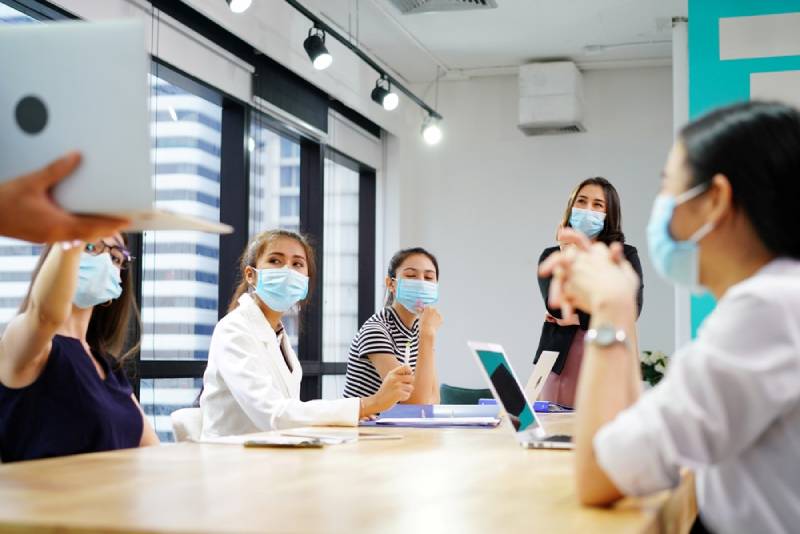7 Steps for Transitioning Your Team Back in the Office After Covid-19

While some businesses have made headlines for keeping their employees permanently at home, many more are planning to return to the office, whether that’s now or in the future. The reasons can be anything from a need for face-to-face interaction with clients and coworkers to data security concerns. This process will require patience, planning, compassion and hard work. Most of all, it requires trust between employees and leadership, and between employees themselves. Fortunately, advances like the development of Covid vaccines and rapid Covid test kits for sale have given us new options for tackling the move back to the office. Below are seven of the most important ways that businesses can take responsibility for Covid safety in their return to working in person.

Table of Contents
1. Follow all federal, state and local laws.
The foundation of a successful return to the office is compliance with government regulations. Of course, we all know that guidance from authorities changes regularly, which is why it’s even more important to monitor the latest updates. For just one example, the Biden administration is expected to soon release a federal rule that mandates vaccination in all businesses with 100 or more employees. Obeying vaccination requirements is obviously important, but they’re only one part of the picture. Many cities and states have imposed additional regulations about employee PPE, sanitation, social distancing and other mitigation measures. Contact your state and/or city’s Department of Labor to learn about the workplace Covid safety rules in your area.
2. Communicate the organization’s reasons for returning to the office.
Employees and managers at all levels need to clearly understand the reasons for returning to work in person. Workers on your team are more likely to cooperate when they understand why the decision is necessary. That only happens when leadership takes the time to get buy-in at all levels of the organization using clear communication.
When possible, communication should come directly from the top decision makers. Now is the time for leaders to step up, own the decisions and articulate their strategy to keep everyone safe. Share the data behind your decision with employees, and engage with them transparently when people voice concerns.
3. Make your return model flexible.
Nothing about pandemics is predictable, so expect the unexpected. People’s health circumstances may change, so having HR software that lets you manage employee information isn’t a crazy idea. Return dates may be moved, office arrangements may change, and office arrangements may change.
Flexibility is also necessary for employees who may still be suffering from the effects of the pandemic. One person might still be feeling the effects of long Covid, while another might suddenly have to scramble for childcare when an exposure closes their child’s school. And with unprecedented numbers of employees leaving their jobs, it’s in every employer’s interest to give employees all the flexibility they can within reason.
4. Create a hybrid model with both home and office options.
Many employers have discovered that hybrid office-WFH models can offer the best of both worlds. In a typical hybrid model, most employees work some days at home and some days in the office. Some employees might work almost entirely in person or at home, depending on their job duties, preferences and medical needs.
A hybrid model acknowledges that employees have different responsibilities and different needs, and that it’s possible to find a compromise that can make everyone happier. Again, with the labor shortage, it’s more important than ever to hang onto great talent, and hybrid work models are likely to continue increasing in popularity.

5. Make it easy for employees to follow safety regulations.
The best way to ensure employees follow the rules is to make compliance as painless as possible. Many employers have added hand sanitizer stations to common areas or begun providing free masks and hand sanitizer to their employees. If your office requires social distancing, install visual reminders like floor stickers to help people develop the habit.
Providing on-site testing and adequate time off are two more important ways you can help ensure that employees are able to follow safety protocols. Stock up on easy-to-use rapid antigen tests like the Abbott BinaxNOW™ Covid test so that employees have ready access to testing. Moreover, communicate clearly that employees aren’t just allowed, but expected to take time off and get tested rather than coming to work sick.
6. Reduce the length and frequency of in-person meetings.
Many offices already have an excessive amount of meetings that drain employees’ energy and productivity. But these extra meetings can also be harmful from a Covid risk control perspective. If an infected person is present, longer face-to-face time and more interactions equal more opportunities for transmission.
Instead, try moving some meetings to video conferencing even when you’re back in the office. If weather permits in your area, you could even try having smaller meetings and one-on-ones outside. And, as always, remember to ask yourself before you schedule a meeting if it could simply be an email or Slack discussion instead.
7. Have detailed response plans for potential exposures in your office.
Sooner or later, it’s likely that someone in your office will be exposed to the virus. If that happens, you should have a Covid response plan ready for action immediately. Since you can’t plan for when an exposure will happen, you need to start planning well in advance.
Ask your HR Software department to help craft policies that are compliant with HIPAA, OSHA and other relevant workplace health and safety standards. Make sure that your business has rapid Covid tests on hand to test potential cases, and develop a contact tracing protocol to alert team members, clients and other contacts when someone tests positive.

Remember that there’s no such thing as “business as usual” anymore, especially when it comes to avoiding viral spread in your workplace. But it’s far from an impossible battle, especially as vaccines continue to roll out and scientists learn more about how to keep the virus at bay. Your business has a chance to come back stronger and better, so use it!

